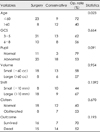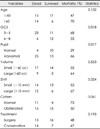Abstract
Objective
Acute subdural hematoma (ASDH) is one of the worst post-traumatic mass lesions. Early aggressive management may reduce the mortality rate, while it may cause unbearable sequelae or disabilities. Traditionally a surgical decision is made by the surgeon on the critical victim without delay. However, it is necessary to inform the relatives or family not only the possibility of survival, but also the quality of life after surgery, especially for the comatose victims with ASDHs. We investigate the outcome of the comatose (Glascow coma scale 3-8) patients with ASDH.
Methods
From January 2005 to December 2006, we managed 141 patients with ASDH. In 52 patients, their initial Glasgow coma score (GCS) was 3-8. We examined the age, initial GCS, size and reflex of pupils, method of treatment, and the outcome at discharge. We also investigated the amount the hematoma, degree of midline shift, and status of the basal cisterns in computed tomographic scans. Statistical significance was tested using the chi-square test. It was considered significant, when p<0.05.
Results
The overall outcome was poor; death in 29, vegetative in 12, severe disability in 10, and moderate disability in 1. There was no good recovery, at all. The outcome was dependent on the initial GCS and pupil. The outcome was independent on the age, amount of the hematoma, degree of midline shift, and method of treatment. However, the age was the only significant factor in deciding not to operate.
Conclusion
In severe head injuries, even though we could save the life, the quality of life is too poor to bother not only the victims, but also their family and society. In this situation, it is never sufficient to explain that an immediate surgery is the only way to save the life. We should provide the information on the outcome of the severe head injuries after surgery.
Figures and Tables
References
1. Albanèse J, Leone M, Alliez JR, Kaya JM, Antonini F, Alliez B, et al. Decompressive craniectomy for severe traumatic brain injury: evaluation of the effects at one year. Crit Care Med. 2003; 31:2535–2538.

2. Becker DP, Miller JD, Ward JD, Greenberg RP, Young HF, Sakalas R. The outcome from severe head injury with early diagnosis and intensive management. J Neurosurg. 1977; 47:491–502.

3. Britt RH, Hamilton RD. Large decompressive craniectomy in the treatment of acute subdural hematoma. Neurosurgery. 1978; 2:195–200.
4. Bullock MR, Chesnut R, Ghajar J, Gordon D, Hartl R, Newell DW, et al. Surgical management of acute subdural hematomas. Neurosurgery. 2006; 58:S16–S24.

5. Choi I, Choi WR, Lee KS, Shim JJ. Deciding not to operate in head injuries and legal considerations. J Korean Neurosurg Soc. 2007; 42:135–140.
6. D'Amato L, Piazza O, Alliata L, Sabia G, Zito G, Frassanito L, et al. Prognosis of isolated acute post-traumatic subdural haematoma. J Neurosurg Sci. 2007; 51:107–111.
7. Dent DL, Croce MA, Menke PG, Young BH, Hinson MS, Kudsk KA, et al. Prognostic factors after acute subdural hematoma. J Trauma. 1995; 39:36–42. discussion 42-43.

8. Hukkelhoven CW, Steyerberg EW, Rampen AJ, Farace E, Habbema JD, Marshall LF, et al. Patient age and outcome following severe traumatic brain injury: an analysis of 5,600 patients. J Neurosurg. 2003; 99:666–673.

9. Jang HS, Lee YB, Chung C, Lee KC, Park YS, Mok JH. Acute subdural hematoma: an analysis of 244 operated cases. J Korean Neurosurg Soc. 1996; 25:111–118.
10. Kim KT. Traumatic acute subdural hematoma: prognosis and operative timing. J Korean Soc Emerg Med. 2000; 11:563–569.
11. Kim ST, Lee JS, Kwon IS, Hong SK, Moon MS. Clinical survey of intracranial acute subdural hematoma. J Korean Neurosurg Soc. 1990; 19:70–78.
12. Lee K, Lee KS, Bae HG, Yun IG, Lee IS. Characteristics of head injury in the aged. J Korean Neurosurg Soc. 1990; 19:1001–1008.
13. Lee KS, Bae HG, Yun IG. Acute subdural hematoma: analysis of 183 operated cases. J Korean Neurosurg Soc. 1992; 21:983–989.
14. Lee SW, Kim OL, Woo BG, Kim SH, Bae JH, Choi BY, et al. Prognostic factors in patients with severe head injury. J Korean Neurosurg Soc. 1999; 28:1288–1292.
15. Marquez de la Plata CD, Hart T, Hammond FM, Frol AB, Hudak A, Harper CR, et al. Impact of age on long-term recovery from traumatic brain injury. Arch Phys Med Rehabil. 2008; 89:896–903.

16. Massaro F, Lanotte M, Faccani G, Triolo C. One hundred and twenty-seven cases of acute subdural hematoma operated on. Correlation between CT scan findings and outcome. Acta Neurochir (Wien). 1996; 138:185–191.
17. Mosenthal AC, Lavery RF, Addis M, Kaul S, Ross S, Marburger R, et al. Isolated traumatic brain injury: age is an independent predictor of mortality and early outcome. J Trauma. 2002; 52:907–911.

18. Ono J, Yamaura A, Kubota M, Okimura Y, Isobe K. Outcome prediction in severe head injury: analyses of clinical prognostic factors. J Clin Neurosci. 2001; 8:120–123.

19. Park JK, Lee KS, Doh JW, Bae HG, Yun IG, Lee IS. Results of decompressive craniectomy in severe head injury. J Korean Neurosurg Soc. 1991; 20:161–166.
20. Sahuquillo J, Arikan F. Decompressive craniectomy for the treatment of refractory high intracranial pressure in traumatic brain injury. Cochrane Database Syst Rev. 2006; (1):CD003983.

21. Sakas DE, Bullock MR, Teasdale GM. One-year outcome following craniotomy for traumatic hematoma in patients with fixed dilated pupils. J Neurosurg. 1995; 82:961–965.

22. Sawauchi S, Abe T. The effect of haematoma, brain injury, and secondary insult on brain swelling in traumatic acute subdural haemorrhage. Acta Neurochir (Wien). 2008; 150:531–536. discussion 536.

23. Taussky P, Widmer HR, Takala J, Fandino J. Outcome after acute traumatic subdural and epidural haematoma in Switzerland: a single-centre experience. Swiss Med Wkly. 2008; 138:281–285.
24. Thompson HJ, McCormick WC, Kagan SH. Traumatic brain injury in older adults: epidemiology, outcomes, and future implications. J Am Geriatr Soc. 2006; 54:1590–1595.

25. Vyas NA, Chicoine MR. Extended survival after evacuation of subdural hematoma in a 102-year-old patient: case report and review of the literature. Surg Neurol. 2007; 67:314–316. discussion 317.

26. Wilberger JE Jr, Harris M, Diamond DL. Acute subdural hematoma: morbidity and mortality related to timing of operative intervention. J Trauma. 1990; 30:733–736.




 PDF
PDF ePub
ePub Citation
Citation Print
Print




 XML Download
XML Download